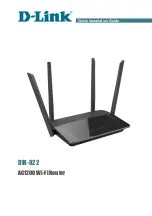
INS_CWGE24MS2_REV–
10/05/16 PAGE 129
INSTALLATION AND OPERATION MANUAL
CWGE24MS2
TECH SUPPORT: 1.888.678.9427
DHCP Option 82 Port Settings
Port
The port ID.
Circuit-ID String
The String of the circuit ID sub-option information for the specific port.
Remote-ID String
The String of the remote ID sub-option information for the specific port.
DHCP Option 82 Port Status
The field displays all of the ports’ configurations.
DHCP Relay
Introduction
Because the DHCPDISCOVER message is a broadcast message, and broadcasts only cross other
segments when they are explicitly routed, you might have to configure a DHCP Relay Agent on
the router interface so that all DHCPDISCOVER messages can be forwarded to your DHCP server.
Alternatively, you can configure the router to forward DHCP messages and BOOTP message. In
a routed network, you would need DHCP Relay Agents if you plan to implement only one DHCP
server.
The DHCP Relay that either a host or an IP router that listens for DHCP client messages being
broadcast on a subnet and then forwards those DHCP messages directly to a configured DHCP
server. The DHCP server sends DHCP response messages directly back to the DHCP relay agent,
which then forwards them to the DHCP client. The DHCP administrator uses DHCP relay agents to
centralize DHCP servers, avoiding the need for a DHCP server on each subnet.
Most of the time in small networks DHCP uses broadcasts however there are some circumstances
where unicast addresses will be used. A router for such a subnet receives the DHCP broadcasts,
converts them to unicast (with a destination MAC/IP address of the configured DHCP server,
source MAC/IP of the router itself). The field identified as the GIADDR in the main DHCP page is
populated with the IP address of the interface on the router it received the DHCP request on. The
DHCP server uses the GIADDR field to identify the subnet the device and select an IP address
from the correct pool. The DHCP server then sends the DHCP OFFER back to the router via
unicast which then converts it back to a broadcast and out to the correct subnet containing the
device requesting an address.
Configurations:
Users can enable/disable the DHCP Relay on the Switch. Users also can enable/disable the DHCP
Relay on a specific VLAN. If the DHCP Relay on the Switch is disabled, the DHCP Relay is disabled
on all VLANs even some of the VLAN DHCP Relay are enabled.
















































